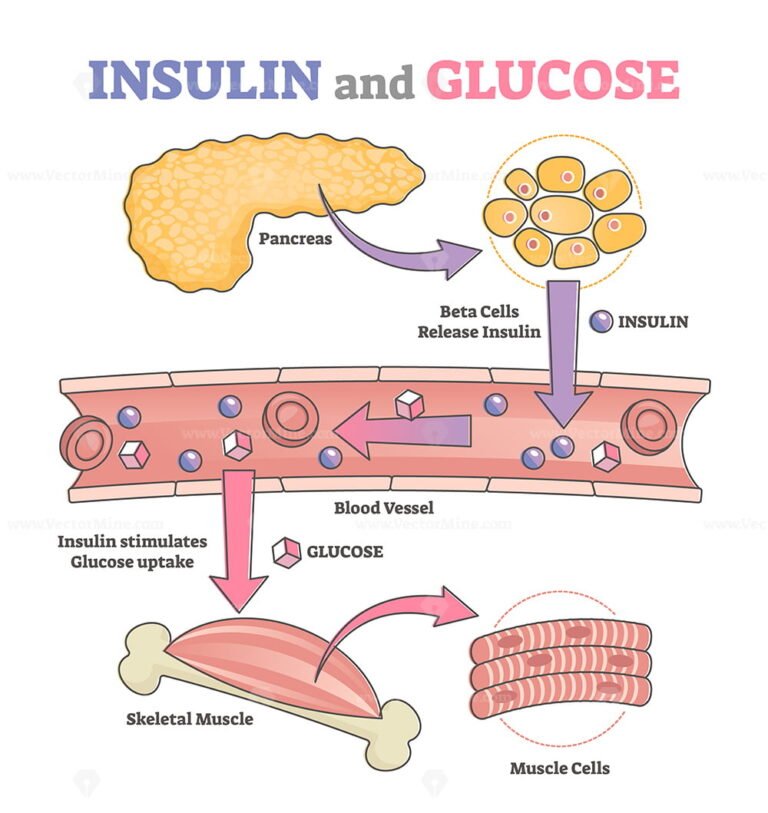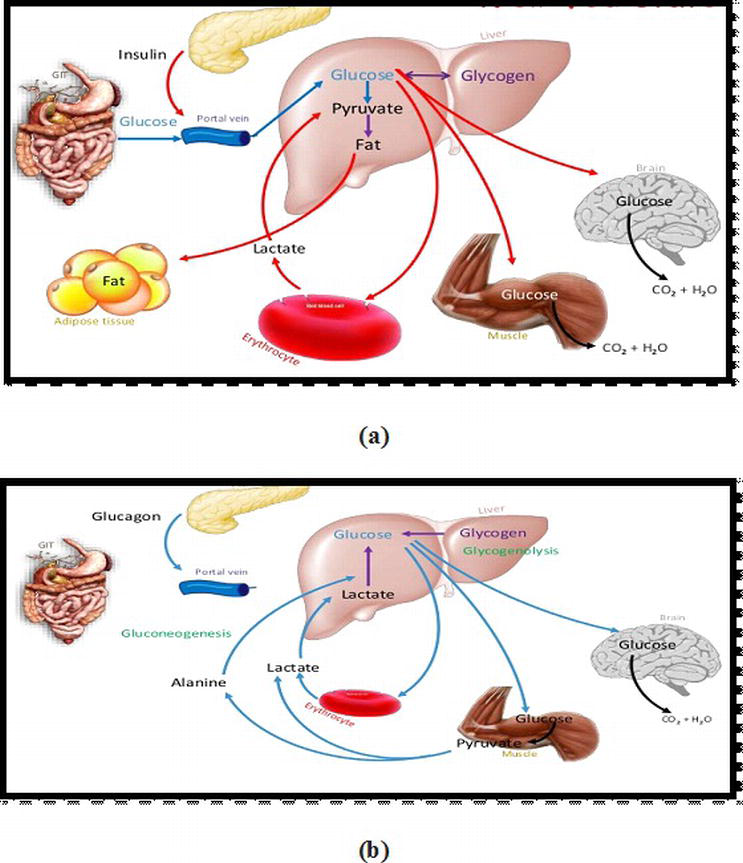Regulation Of Insulin : What it is

The image above depicts an educational scheme outlining the regulation of insulin and glucose release in our bodies. It emphasizes the important relationship between insulin and glucose in maintaining optimal health. Understanding this process is crucial for individuals managing conditions such as diabetes or those interested in improving their overall well-being.
Understanding Insulin Regulation
Insulin plays a crucial role in maintaining our blood glucose levels. When we consume carbohydrates, our bodies break them down into glucose, which then enters our bloodstream. As blood sugar levels rise, the pancreas releases insulin to facilitate the uptake of glucose by our cells. Insulin acts as a key that unlocks the cells, allowing glucose to enter and be used for energy production. Additionally, insulin helps store excess glucose in the liver for later use.
Impacts of Imbalanced Insulin Levels
When insulin regulation is disrupted, various health complications can arise. Here are some potential consequences of imbalanced insulin levels:
-
Diabetes Mellitus
Diabetes mellitus is a chronic condition characterized by high blood sugar levels. In type 1 diabetes, the pancreas fails to produce insulin, while in type 2 diabetes, the body becomes insulin resistant, leading to inadequate insulin utilization. Both conditions can result in serious health consequences if left unmanaged.
-
Weight Gain and Obesity
Imbalanced insulin levels can contribute to weight gain and obesity. When insulin levels are consistently high, as seen in insulin resistance or chronic hyperinsulinemia, the body's ability to burn fat for energy becomes compromised. This can lead to weight gain and difficulty losing excess pounds.
-
Cardiovascular Complications
Poor insulin regulation is associated with an increased risk of cardiovascular diseases. Insulin resistance and high blood sugar levels can damage blood vessels, increase inflammation, and raise blood pressure, all contributing factors to heart disease, stroke, and other cardiovascular complications.

The image above illustrates the role of insulin and glucagon in the regulation of blood glucose levels. Glucagon is another hormone produced by the pancreas that works in partnership with insulin to maintain a stable blood sugar balance. While insulin promotes glucose uptake by cells, glucagon stimulates the liver to release stored glucose when blood sugar levels are low.
How to Maintain Optimal Insulin Levels
To ensure proper insulin regulation and promote overall well-being, consider the following tips:
-
Follow a Balanced Diet
Consuming a balanced diet that includes whole grains, lean proteins, healthy fats, and plenty of fruits and vegetables is essential for maintaining optimal insulin levels. Avoid excessive consumption of sugary foods and drinks, as they can lead to insulin spikes and increased health risks.
-
Engage in Regular Exercise
Physical activity plays a significant role in insulin regulation. Regular exercise helps improve insulin sensitivity, allowing cells to utilize glucose more efficiently. Aim for a combination of cardiovascular exercises, strength training, and flexibility exercises to reap the most benefits.
-
Manage Stress Levels
Chronic stress can negatively impact insulin regulation. Find healthy ways to manage stress, such as practicing mindfulness, engaging in relaxation techniques, or pursuing hobbies that bring you joy. Prioritizing self-care can have a profound effect on your overall health and insulin levels.
Frequently Asked Questions (FAQs)
1. What is insulin resistance?
Insulin resistance occurs when the cells in our body become less responsive to the effects of insulin. As a result, higher levels of insulin are required to maintain normal blood sugar levels. Insulin resistance is commonly associated with obesity, sedentary lifestyle, and poor dietary choices.
2. Can insulin regulation prevent diabetes?
While insulin regulation alone cannot completely prevent diabetes, it plays a crucial role in managing and preventing complications associated with the disease. By maintaining optimal insulin levels through lifestyle interventions, such as diet, exercise, and stress management, individuals can reduce their risk of developing type 2 diabetes or minimize its impact if already diagnosed.
3. Are insulin injections the only treatment for diabetes?
Insulin injections are one of the treatment options for individuals with diabetes. Depending on the type and severity of the condition, other treatment approaches, such as oral medications or lifestyle modifications, may be recommended. It is essential to work closely with healthcare professionals to determine the most suitable treatment plan for individual needs.
In conclusion, understanding the regulation of insulin and its impact on our overall health is crucial for maintaining a balanced and thriving lifestyle. By adopting healthy habits, managing stress, and staying proactive in our well-being, we can optimize our insulin levels and reduce the risk of developing complications associated with imbalanced insulin regulation. Remember to consult with healthcare professionals for personalized advice and support on managing insulin-related concerns.Regulation Of Glycogen Synthesis And Breakdown - Principles Of
 Image Source : jackwestin.com
Image Source : jackwestin.com Pin On Biology
 Image Source : www.pinterest.fr
Image Source : www.pinterest.fr regulation pancreatic endocrino insulin glucagon hormones veterinaria insulina endocrine slideplayer células glucagón islote glucosa
🌷 Homeostasis Blood Sugar Regulation. Homeostasis And Blood Glucose
 Image Source : opportunities.alumdev.columbia.edu
Image Source : opportunities.alumdev.columbia.edu The Influence Of Blood Sugar On Weight Loss
 Image Source : www.mz-store.com
Image Source : www.mz-store.com insulin glucagon
Insulin And Glucose Release Regulation Educational Scheme Outline
 Image Source : vectormine.com
Image Source : vectormine.com insulin glucose insulina regulation rilascio glycogen glucosio uptake pädagogisches entwurfs entwurfskonzept educativo concetto regolamento vectormine cellula dalla mischen bewegliche anatomical
4. Regulation Of Blood Glucose | ATrain Education
 Image Source : atrainceu.com
Image Source : atrainceu.com insulin glucose glucagon diabetes glukagon hormon fungsi roles fasting complementary mekanisme hormone pancreas glycogen menghasilkan shaklee starving liver insulina homeostasis
Describe The Role Of Insulin In Regulating Blood Sugar Levels
 Image Source : jeandesnhconner.blogspot.com
Image Source : jeandesnhconner.blogspot.com Insulin Resistance In Diabetes: The Promise Of Using Induced
 Image Source : www.wjgnet.com
Image Source : www.wjgnet.com insulin resistance cell stem cells diabetes pathway wjsc i3 v13
Insulin glucagon. Pin on biology. Insulin glucose insulina regulation rilascio glycogen glucosio uptake pädagogisches entwurfs entwurfskonzept educativo concetto regolamento vectormine cellula dalla mischen bewegliche anatomical. Insulin resistance cell stem cells diabetes pathway wjsc i3 v13. 🌷 homeostasis blood sugar regulation. homeostasis and blood glucose